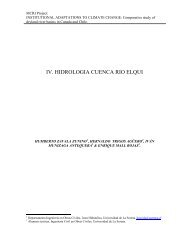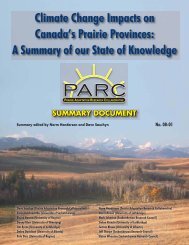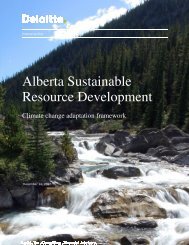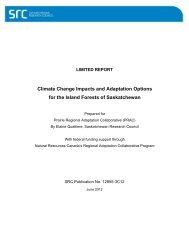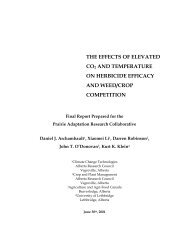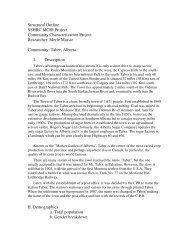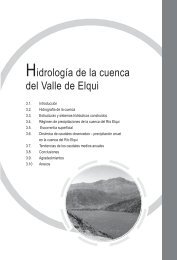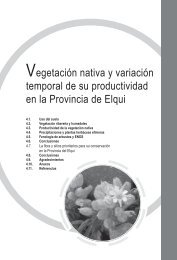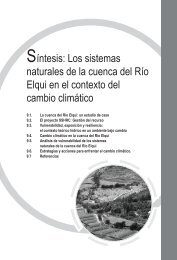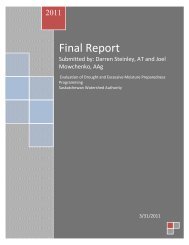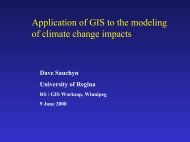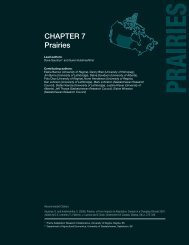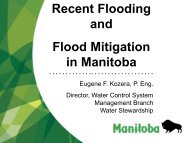Exotic Tree Species as an Adaptation Option to Climate Change in ...
Exotic Tree Species as an Adaptation Option to Climate Change in ...
Exotic Tree Species as an Adaptation Option to Climate Change in ...
Create successful ePaper yourself
Turn your PDF publications into a flip-book with our unique Google optimized e-Paper software.
Introduction<br />
Under conditions of climate ch<strong>an</strong>ge, ma<strong>in</strong>ta<strong>in</strong><strong>in</strong>g species <strong>an</strong>d<br />
ecosystem diversity <strong>in</strong> the western boreal forest may require<br />
<strong>in</strong>cre<strong>as</strong><strong>in</strong>gly <strong>in</strong>tensive m<strong>an</strong>agement policies. The purpose of<br />
this summary is <strong>to</strong> <strong>as</strong>sess the possibility of <strong>in</strong>troduc<strong>in</strong>g new<br />
tree species <strong>in</strong><strong>to</strong> the western boreal forest <strong>as</strong> <strong>an</strong> adaptation<br />
<strong>to</strong> climate ch<strong>an</strong>ge, <strong>an</strong>d discuss government policies <strong>to</strong><br />
address this issue. The regional focus is on the Boreal Pla<strong>in</strong><br />
Ecozone of M<strong>an</strong>i<strong>to</strong>ba, S<strong>as</strong>katchew<strong>an</strong>, <strong>an</strong>d Alberta. This<br />
region encomp<strong>as</strong>ses the ma<strong>in</strong> are<strong>as</strong> of production forestry <strong>in</strong><br />
these prov<strong>in</strong>ces, but also <strong>in</strong>cludes parks <strong>an</strong>d other protected<br />
are<strong>as</strong>, <strong>as</strong> well <strong>as</strong> are<strong>as</strong> along the southern fr<strong>in</strong>ge of the region<br />
where forest h<strong>as</strong> been cleared for agriculture.<br />
The study looks beyond the Prairie region <strong>to</strong> ga<strong>in</strong> a global<br />
perspective on the benefits of exotic tree species, the threats<br />
posed by these exotics, <strong>an</strong>d methods for <strong>as</strong>sess<strong>in</strong>g their<br />
<strong>in</strong>v<strong>as</strong>iveness. Next is <strong>an</strong> <strong>as</strong>sessment of present <strong>an</strong>d future<br />
climatic suitability for a number of native <strong>an</strong>d non-native<br />
tree species <strong>to</strong> the region under study. Seven non-native<br />
species are exam<strong>in</strong>ed <strong>in</strong> greater detail <strong>to</strong> determ<strong>in</strong>e their<br />
suitability for <strong>in</strong>troduction. F<strong>in</strong>ally, <strong>an</strong> exam<strong>in</strong>ation of<br />
global, federal, <strong>an</strong>d prov<strong>in</strong>cial policies on exotic tree species<br />
provides further context for the development of a new policy<br />
perspective on the issue <strong>an</strong>d policy recommendations.<br />
Rationale for Introduc<strong>in</strong>g <strong>Exotic</strong> <strong>Species</strong><br />
M<strong>an</strong>y re<strong>as</strong>ons exist for <strong>in</strong>troduc<strong>in</strong>g exotic tree species<br />
throughout the world. <strong>Exotic</strong> species provide a number<br />
of benefits <strong>to</strong> forestry <strong>in</strong> particular. In m<strong>an</strong>y c<strong>as</strong>es, exotic<br />
species grow f<strong>as</strong>ter th<strong>an</strong><br />
native species, have greater<br />
seed availability, are more<br />
e<strong>as</strong>ily m<strong>an</strong>aged, <strong>an</strong>d are better<br />
unders<strong>to</strong>od by foresters.<br />
Introduction of exotic trees<br />
c<strong>an</strong> also provide benefits <strong>to</strong><br />
the l<strong>an</strong>d <strong>an</strong>d ecosystems. Their<br />
<strong>in</strong>troduction h<strong>as</strong> frequently<br />
been justified by their value <strong>in</strong><br />
reclamation of disturbed are<strong>as</strong>,<br />
such <strong>as</strong> eroded l<strong>an</strong>ds (Zobel<br />
et al. 1987). F<strong>as</strong>t-grow<strong>in</strong>g<br />
exotic pl<strong>an</strong> tations also tend <strong>to</strong><br />
reduce the need for <strong>in</strong>tensive<br />
m<strong>an</strong>agement of the rema<strong>in</strong><strong>in</strong>g<br />
natural forest (Zobel et al.<br />
1987). It h<strong>as</strong> even been argued<br />
that exotic species c<strong>an</strong> have<br />
positive ecological value by<br />
contribut<strong>in</strong>g <strong>to</strong> the structure<br />
or function of a particular<br />
ecosystem (Williams 1997).<br />
A new rationale for <strong>in</strong>troduction<br />
of exotic trees is their<br />
possible role <strong>in</strong> adaptation <strong>to</strong><br />
climate ch<strong>an</strong>ge. Recent climate<br />
ch<strong>an</strong>ge <strong>as</strong>sessments <strong>in</strong> the Figure 1: Carag<strong>an</strong>a bushes<br />
3<br />
Prairie Prov<strong>in</strong>ces have made the po<strong>in</strong>t that the climate may<br />
become less suitable for native trees <strong>in</strong> some are<strong>as</strong>, lead<strong>in</strong>g<br />
<strong>to</strong> reduced growth, regeneration failure, <strong>an</strong>d gradual loss of<br />
forest cover. Retention of the economic <strong>an</strong>d environmental<br />
values <strong>as</strong>sociated with forest may require <strong>in</strong>troduction of<br />
exotic varieties or species that are adapted <strong>to</strong> the warmer <strong>an</strong>d<br />
drier climate (Thorpe et al. 2001, Henderson et al. 2002).<br />
Williams (1997) argued that exotic pl<strong>an</strong>ts now considered<br />
problematic may turn out <strong>to</strong> have ecological value <strong>in</strong> the<br />
future because of climate ch<strong>an</strong>ge, by fill<strong>in</strong>g the ecological<br />
roles played by native species that have been elim<strong>in</strong>ated.<br />
Threats from Introduc<strong>in</strong>g <strong>Exotic</strong> <strong>Tree</strong> <strong>Species</strong><br />
<strong>Exotic</strong> species c<strong>an</strong> pose a number of threats <strong>to</strong> regions <strong>an</strong>d<br />
ecosystems. Threats of dise<strong>as</strong>e tr<strong>an</strong>smission, genetic crosshybridization,<br />
site degradation, <strong>an</strong>d biodiversity loss have<br />
been documented <strong>in</strong> various regions of the world. Globally<br />
the most import<strong>an</strong>t threat attached <strong>to</strong> the <strong>in</strong>troduction<br />
of exotic pl<strong>an</strong>ts is the potential for <strong>in</strong>v<strong>as</strong>ion of adjacent<br />
ecosystems. While most successful <strong>in</strong>v<strong>as</strong>ions do not alter<br />
large-scale ecosystem processes, some <strong>in</strong>v<strong>as</strong>ions do have<br />
major impacts (Vi<strong>to</strong>usek 1990). This happens <strong>in</strong> situations<br />
<strong>in</strong> which <strong>in</strong>vaders:<br />
• Differ subst<strong>an</strong>tially from natives <strong>in</strong> resource<br />
acquisition or utilization<br />
• Alter the trophic structure of the <strong>in</strong>vaded area<br />
• Alter disturb<strong>an</strong>ce frequency <strong>an</strong>d/or <strong>in</strong>tensity<br />
Depend<strong>in</strong>g on the situation, certa<strong>in</strong> exotics are deemed<br />
<strong>to</strong> be more <strong>in</strong>v<strong>as</strong>ive th<strong>an</strong> others. In C<strong>an</strong>ada, the follow<strong>in</strong>g



